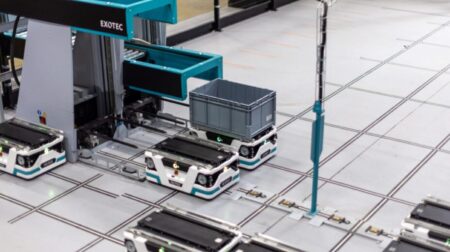Wireless automated guided vehicle (AGVs) and autonomous mobile robot (AMR) charging, also known as wireless charging or inductive charging for AGVs, is a form of cable-free technology for powering mobile robotic solutions.
The majority of mobile robotics solutions require charging time and infrastructure in order to deliver the benefits of automation to the facility in which they are deployed.
However, installing charging infrastructure can lead to operational downtime, among other upsets to operational workflows, which can be frustrating for firms waiting for an ROI after investing in automation.
In contrast to traditional charging solutions, wireless charging solutions offer benefits such as increased uptime, improved flexibility and safety, scalability and optimised resource allocation.
How does it work?
Wireless AGV charging relies on electromagnetic induction to transfer power from a charging station to the AGV or AMR’s onboard battery. The process involves two main components: the charging station and the receiver unit installed on the AGV or AMR. These components work together seamlessly to enable automated charging without human intervention.
Productivity
Wireless robot chargers enable robots to autonomously recharge their batteries without human intervention. This capability reduces downtime by enabling robots to recharge whenever needed, ensuring continuous operation and often leading to increases in productivity.
Such an approach offers numerous advantages in industrial automation and logistics operations by also eliminating the need for manual connection of charging cables, meaning lead times and installation processes are much faster.
Another of the primary benefits of wireless AGV charging is increased efficiency. Traditional charging methods often require AGVs to dock at designated charging stations, which can lead to downtime as vehicles wait for their batteries to recharge.
With wireless charging, AGVs can charge their batteries while on the move, thus minimising downtime. This is particularly advantageous in industries with continuous production processes, where even short delays can have significant implications for overall efficiency.
Resources
By enabling efficient charging that reduces impact on workflows, this optimisation of resource allocation ensures that robots spend more time performing valuable tasks, which can maximise output with minimal resources.
It also allows for better utilisation of resources, such as energy and charging infrastructure, leading to cost savings and improved operational efficiency.
By introducing solutions that enable robots to autonomously navigate to charging stations, firms can implement smarter charging strategies. These could include opportunistic charging during idle periods or on-demand charging based on the robots’ battery levels.
This added flexibility means robots to operate in environments with more complicated layouts and infrastructure, or where there are dynamic obstacles and reduces the need to add further resources to a deployment.
Scalability
Wireless charging systems can be easily scaled to accommodate changes in the size or configuration of robot fleets. Additional charging stations can be deployed as needed to support growing operational demands and existing stations can be relocated or reconfigured to optimise charging coverage.
This scalability and adaptability make wireless charging well-suited for evolving automation requirements and dynamic work environments, which are particularly common across the manufacturing and e-commerce market segments.
By using wireless solutions, site managers can help scale and future-proof their investments in industrial automation as these can accommodate for changes. An example of this could be during peak periods, where the addition of new AGVs or the reconfiguration of production layouts may be needed to meet demand.
This scalability ensures that businesses can adapt to changing market conditions and maintain a competitive edge in their respective industries.
Effects on staff
Moreover, wireless charging eliminates the need for manual intervention, reducing labour costs and improving safety in industrial environments. This is because removing the need for physical connection to charging cables means less risk of tripping hazards and damage to equipment. This not only enhances workplace safety but also reduces the likelihood of downtime due to accidents or equipment damage.
As businesses continue to embrace automation and seek innovative solutions to improve efficiency, wireless AGV charging could play a central role in shaping the future of industrial automation.









